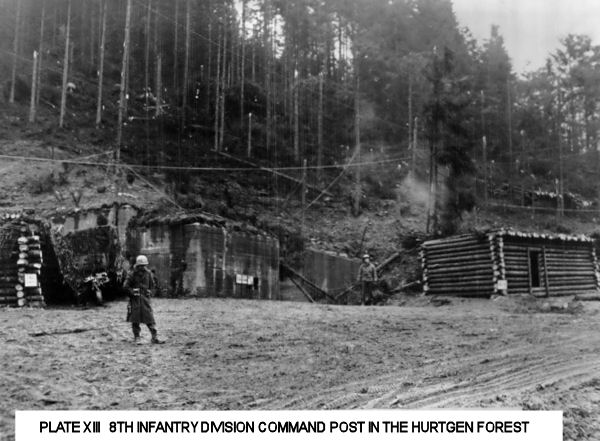CHAPTER VI
The 709th Tank Battalion in support of the 8th Infantry Division
"The failure of the 28th Infantry Division to take SCHMIDT made it necessary for the First Army and V Corps to secure another road which would serve as a supply route in the push to the ROER RIVER;" (1) and to effect the seizure of the vital dams that influenced all operations to the north. "An alternate route was found in the road through HÜRTGEN to KLEINHAU. Not only were there several approaches to the road but possession of the positions around HÜRTGEN on the KLEINHAU-BERGSTEIN RIDGE would give the American forces observation while denying it to the enemy." (2)
On 14 November 1944 the battered 28 Infantry Division was relieved from the HURTGEN front and began a mutual interchange of positions with the 8th Infantry Division which was 1ocated in the relatively quiet VIII Corps sector to the south, and on 19 November the 709th Tank Battalion, which had been attached to the 8th Infantry Division throughout the European campaign, relieved in place the 707th Tank Battalion, the armored support of the 28th Infantry Division.
Oral orders from the commanding general of V Corps were received by the 8th Infantry Division early on the evening of 19 November necessitating a hurried move of the 121st Infantry Regiment which was still in LUXEMBOURG. A letter of instructions followed which directed the attachment of CCR, 5th Armored Division, to the 8th Infantry Division for an attack to seize the HÜRTGEN-KLEINHAU-BERGSTEIN RIDGE on 21 November (see Chapter VII).
"In order to carry out the corps directive it was planned to divide the action into two phases. During Phase I the 121st Infantry Regiment, reinforced, was to pass through the 12th Regiment, 4th Infantry Division, and commencing at 210900 November was to seize as its first objective the northern and eastern edges of the forest south and west of HÜRTGEN." (3) This would provide a line of departure for CCR, 5th armored Division, to initiate Phase II by its advance under cover of darkness from the west to seize HÜRTGEN and KLEINHAU and the ridge on which these towns were located. The 121st Regiment was then to relieve CCR, occupy HÜRTGEN, KLEINHAU, HILL 401 (F058377), and defend the ridge from counterattacks from the northeast and southeast while CCR continued the attack to BERGSTEIN. The account of Phase II can be found in Chapter VII.
The 121st Regiment had attached the 12th Engineer Bn., to clear the road to HÜRTGEN which was heavily mined and obstructed by fallen trees. No serious threat from German armor was expected during the attack through the forest but there was a strong possibility of counterattacks when the edge of the forest was reached. To counter this possibility Company A, 644th TD Battalion, was attached to the regiment.
The other regiments were to have little part in the attack on HÜRTGEN. The 28th Regiment was to remain in position in VOSSENACK and the 13th was to occupy defensive positions just north of the KALL RIVER.
The portion of the forest through which the attack on the town of HÜRTGEN had to pass lay generally along and west of the HÜRTGEN-GERMETER ROAD. The Germans had correctly evaluated the defensive capabilities of the heavily wooded, boggy, irregular terrain which was cut by numerous gullies and steep cliffs. They had prepared elaborate positions of wire entanglements, minefields, log bunkers, pillboxes and prepared fires, "Maps of the forest used by the Germans had each section marked; when the observers in the log bunkers heard a noise in any section they called for fire on that point." (4) The mud, rain, and sleet of early winter added to the formidable nature of the obstacles opposing the American forces.
The German troops opposing the attack of the 8th Infantry Division were not of the best quality. Their forces consisted of many provisional units which were formed of exceptionally old or young men many of whom had never been in combat and stragglers from units that had been disorganized in FRANCE. Some of the enemy units identified were, Combat Team WEINEN consisting of about 400 men, elements of the 89th Division and other non-divisional units. The morale of the defenders was generally low and for that reason certain of the SS troops were stationed west of the ROER to discourage any notion of surrender. A scarcity of officers was indicated with all platoons and most companies being commanded by non-commissioned officers. In several cases 2nd Lts commanded battalions. The poor quality of the defenders, however, was more than offset by the elaborateness of the defense. All approaches to the clearing in which the town of HÜRTGEN was located passed through dense woods with the two roads approaching from the west having sharp bends which provided ideal sites for strongpoints. The Germans took full advantage of these positions as outposts.
The frustrating obstacles of mud, mines, and limited mobility in the tangled masses of trees forced the 709th Tank Battalion to be employed largely by platoons throughout the HURTGEN operation. Even in this strength the available ground for maneuver was so limited that tank operations frequently came to a standstill when a single tank immobilized by mines or mud blocked the path of the canalized column. The tanks played a minor role in the initial attack toward HÜRTGEN, and except during the attack on the town itself never rose above a supporting role during the entire operation.


